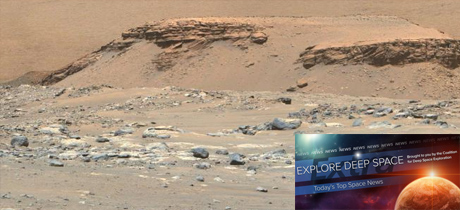In Today’s Deep Space Extra… RS-25 engines begin a new series of testing. The Perseverance rover finds organic chemicals and evidence of volcanic lava flows on Mars.
Human Spaceflight
NASA fires up Artemis RS-25 rocket engines with new component at Stennis Space Center
Supertalk Mississippi (12/15): December 15 marked the beginning of a new series of testing for state-of-the-art RS-25 engines to help power the Space Launch System (SLS) on future missions to the Moon and Mars. The first hot fire of the new series was conducted for a full-duration 500 seconds on the Fred Haise Test Stand (formerly A-1 Test Stand) at Stennis Space Center, near Bay St. Louis, Mississippi. RS-25 tests at Stennis are conducted by a combined team of NASA, Aerojet Rocketdyne and Syncom Space Services operators. Syncom Space Services, a joint venture between BWXT and PAE Applied Technologies, is the prime contractor for Stennis facilities and operations.
MDA discusses status, mission objectives of Canada’s LEAP lunar rover
NASAspaceflight.com (12/10): Canada’s contribution to the Gateway in the form of Canadarm3, among other elements, has been in work for over a year at this point. However, the first flight contribution from that country for lunar settlement is scheduled to come in the form of the Lunar Leap Accelerator Program (LEAP) rover to help better understand how we can maintain a continued human presence on the Moon. The LEAP rover will be approximately 24 kg and will be capable of surviving at least two lunar days and one lunar night, which is equal to 42 days on Earth. The rover will carry a minimum of two scientific payloads totaling 6 kg, one of which is sponsored by NASA.
Space Science
Perseverance rover makes ‘completely unexpected’ volcanic discovery on Mars
CNN.com (12/15): In February, the Perseverance rover landed successfully at Mars in Jezero Crater, believed to have once been a crater lake. However, mission data presented Wednesday at the American Geophysical Union session underway this week, suggests Perseverance has been driving over material from long ago volcanic lava flows rather than bedrock, a surprise. Crystal structures within the rocks that the rover has drilled into so far to gather samples furnished the evidence for a volcanic origin of the material. There is also evidence the Mars rocks have interacted with water on Mars multiple times and host organic materials, the building blocks of life. So far, Perseverance has gathered four of a potential more than 40 samples that NASA is working to return to Earth on a future mission by partnering with the European Space Agency (ESA).
Scientists spot water ice under the ‘Grand Canyon’ of Mars
Space.com (12/15): Data from the European and Russian space agencies Trace Gas Orbiter suggests that Valles Marineris, a massive canyon on Mars, may host large quantities of water ice just below the surface. Valles Marineris, 10 times longer and five times deeper than the Grand Canyon, is the solar system’s largest canyon. Findings from data gathered between 2018 and 2021 are to be published in the journal Icarus in March. The Trace Gas Orbiter was launched in March of 2016 and entered orbit around the Red Planet in October of 2016.
NASA mission could blast an asteroid that once menaced Earth
Indian Express (12/15): Next month, those managing NASA’s OSIRIS-Rex sample return mission to the asteroid Bennu expect to propose that after the spacecraft drops off samples of Bennu to Earth in September 2023 the probe’s mission be extended. They propose that OSIRIS-Rex make three Earth flybys to place it on a course to rendezvous with Apophis, a near Earth asteroid that was once predicted to pose a possible impact threat to the Earth in April of 2029. OSIRIS-Rex could orbit Apophis, which is about 1,000 feet across, in June 2029 and possibly descend close to the asteroid’s surface to learn more about its composition.
Other News
Chinese Kuaizhou-1A rocket launch fails
SpaceNews.com (12/15): A Kuaizhou- 1A solid rocket launched by the Chinese company Exspace on Tuesday failed to reach orbit, causing the loss of two commercial Geespace navigation satellites developed to support autonomous automobile driving. An investigation was underway.

